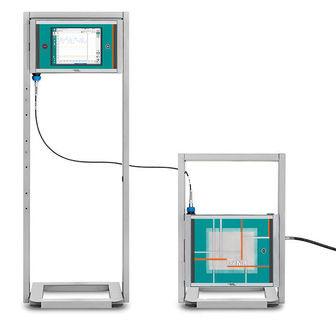To use all functions of this page, please activate cookies in your browser.
my.bionity.com
With an accout for my.bionity.com you can always see everything at a glance – and you can configure your own website and individual newsletter.
- My watch list
- My saved searches
- My saved topics
- My newsletter
Bayesian inference in phylogenyBayesian inference in phylogeny generates a posterior distribution for a parameter, composed of a phylogenetic tree and a model of evolution, based on the prior for that parameter and the likelihood of the data, generated by a multiple alignment. The Bayesian approach has become more popular due to advances in computational machinery, especially, Markov Chain Monte Carlo algorithms. Bayesian inference has a number of applications in molecular phylogenetics, for example, estimation of species phylogeny and species divergence times. Product highlight
Basic Bayesian TheoryRecall that for Bayesian inference:
The denominator
where In the original Metropolis algorithm, given a current The LOCAL algorithm of Larget and SimonThe LOCAL algorithm begins by selecting an internal branch of the tree at random. The nodes at the ends of this branch are each connected to two other branches. One of each pair is chosen at random. Imagine taking these three selected edges and stringing them like a clothesline from left to right, where the direction (left/right) is also selected at random. The two endpoints of the first branch selected will have a sub-tree hanging like a piece of clothing strung to the line. The algorithm proceeds by multiplying the three selected branches by a common random amount, akin to stretching or shrinking the clothesline. Finally the leftmost of the two hanging sub-trees is disconnected and reattached to the clothesline at a location selected uniformly at random. This is the candidate tree. Suppose we began by selecting the internal branch with length $$ Assessing ConvergenceSuppose we want to estimate a branch length of a 2-taxon tree under JC, in which n1 sites are unvaried and n2 are variable. Assume exponential prior distribution with rate for unvaried sites, and Thus the unnormalized posterior distribution is: or, alternately, Update branch length by choosing new value uniformly at random from a window of half-width where Example: Metropolis-coupled MCMC (Geyer)If the target distribution has multiple peaks, separated by low valleys, the Markov chain may have difficulty in moving from one peak to another. As a result, the chain may get stuck on one peak and the resulting samples will not approximate the posterior density correctly. This is a serious practical concern for phylogeny reconstruction, as multiple local peaks are known to exist in the tree space during heuristic tree search under maximum parsimony (MP), maximum likelihood (ML), and minimum evolution (ME) criteria, and the same can be expected for stochastic tree search using MCMC. Many strategies have been proposed to improve mixing of Markov chains in presence of multiple local peaks in the posterior density. One of the most successful algorithms is the Metropolis-coupled MCMC (or In this algorithm, $m$ chains are run in parallel, with different stationary distributions so that the first chain is the cold chain with the correct target density, while chains At the end of the run, output from only the cold chain is used, while those from the hot chains are discarded. Heuristically, the hot chains will visit the local peaks rather easily, and swapping states between chains will let the cold chain occasionally jump valleys, leading to better mixing. However, if An obvious disadvantage of the algorithm is that
References
Categories: Bioinformatics | Phylogenetics | Computational phylogenetics |
|||||||||||||
| This article is licensed under the GNU Free Documentation License. It uses material from the Wikipedia article "Bayesian_inference_in_phylogeny". A list of authors is available in Wikipedia. | |||||||||||||






 is the marginal probability of the data, averaged over all possible parameter values weighted by their prior distribution. Formally,
is the marginal probability of the data, averaged over all possible parameter values weighted by their prior distribution. Formally,

 is the parameter space for
is the parameter space for  .
.
 , and a new
, and a new  , the new value is accepted with probability:
, the new value is accepted with probability:

 (in Figure (a) (to be added)) that separates taxa
(in Figure (a) (to be added)) that separates taxa  and
and  from the rest. Suppose also that we have (randomly) selected branches with lengths
from the rest. Suppose also that we have (randomly) selected branches with lengths  and
and  from each side, and that we oriented these branches as shown in Figure(b). Let
from each side, and that we oriented these branches as shown in Figure(b). Let  , be the current length of the clothesline. We select the new length to be
, be the current length of the clothesline. We select the new length to be  , where
, where  is a uniform random variable on
is a uniform random variable on  . Then for the LOCAL algorithm, the acceptance probability can be computed to be:
. Then for the LOCAL algorithm, the acceptance probability can be computed to be:

 . The density is
. The density is  . The probabilities of the possible site patterns are:
. The probabilities of the possible site patterns are:




 centered at the current value:
centered at the current value:

 is uniformly distributed between
is uniformly distributed between  and
and 
 ,
,  . We will compare results for two values of
. We will compare results for two values of  and
and  . In each case, we will begin with an initial length of
. In each case, we will begin with an initial length of  and update the length
and update the length  times. (See Figure 3.2 (to be added) for results.)
times. (See Figure 3.2 (to be added) for results.)
 ).
).
 , $$
, $$ , where the first one,
, where the first one,  is the target density, while
is the target density, while  ,
,  are chosen to improve mixing. For example, one can choose incremental heating of the form:
are chosen to improve mixing. For example, one can choose incremental heating of the form:
![\pi_j(\theta) = \pi(\theta)^{1/[1+\lambda(j-1)]}, \ \ \lambda > 0,](images/math/0/a/9/0a92c55cd0f1382ba3204894312ec843.png)
 are heated chains. Note that raising the density
are heated chains. Note that raising the density  with
with  has the effect of flattening out the distribution, similar to heating a metal. In such a distribution, it is easier to traverse between peaks (separated by valleys) than in the original distribution. After each iteration, a swap of states between two randomly chosen chains is proposed through a Metropolis-type step. Let
has the effect of flattening out the distribution, similar to heating a metal. In such a distribution, it is easier to traverse between peaks (separated by valleys) than in the original distribution. After each iteration, a swap of states between two randomly chosen chains is proposed through a Metropolis-type step. Let  be the current state in chain
be the current state in chain  ,
,  and
and 
 is unstable, proposed swaps will seldom be accepted. This is the reason for using several chains which differ only incrementally. (See Figure3.3 (to be added)).
is unstable, proposed swaps will seldom be accepted. This is the reason for using several chains which differ only incrementally. (See Figure3.3 (to be added)).
 chains are run and only one chain is used for inference. For this reason,
chains are run and only one chain is used for inference. For this reason, 

